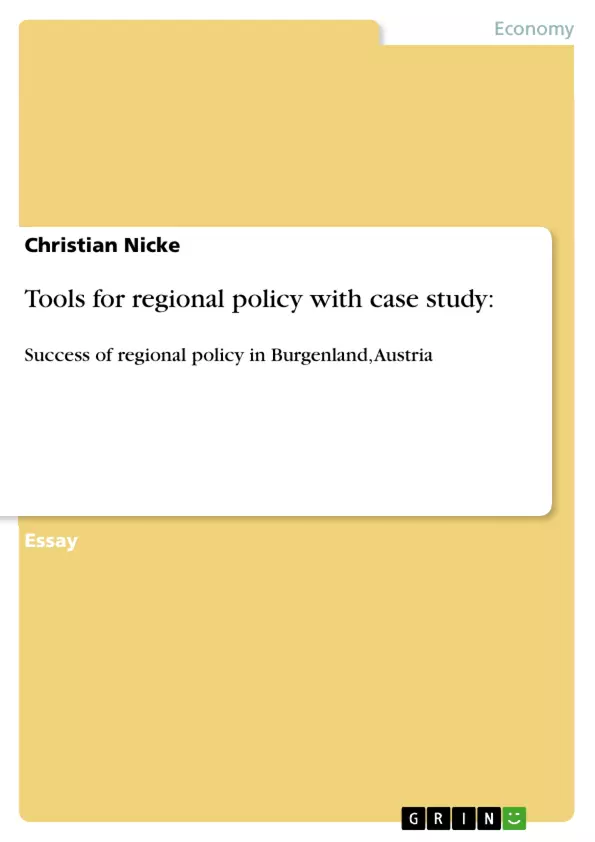As first approach to the topic it seems helpful to me to define which factors make a region. In general the literature mentions three ways how regions could be differentiated:
• Definition through enumeration, i.e. with examples
• Definition in the negative through enumeration of “non-regions”
• Definition on basis if constructive criteria
Most common in literature is the last approach, meanwhile the European Union in particular also follows the first possibility for defining the regions within the E.U. As a workable definition of a region the following definition on basis of constructive criteria is suggested:
Regions
A region is a geographical part of a whole economy that could be identified by means of political and administrative institutions. As constructive criteria a region is defined through free trade between certain regions, mobility of production factors, consistent currency, fiscal and macro-economic policy and shared (superior) institutions.
The wider a nations’ area is and the more regions a nation contains, the bigger the chance that the regions have different levels of economic development and economic power. The overall development of an economy is the sum of the development of the individual regions, more exactly the sum of individual economies. From this follows that the economic power of the certain regions must be bettered should the macroeconomic development be improved. This cognition lead to the development of a special field of public policy: regional (economic) policies. Regional policy should achieve two major goals:
• maximise economic growth and
• minimise social costs
As I would show in the next chapter, regional (economic) policy includes a number of instruments. From this the definition of regional policy is as follows:
Regional policy
Regional policy is the sum of law, strategies and measures for setting and influencing a framework and processes in particular areas of a nation through the government. With special regional policy government seeks to reduce spatial disparities in economic.
Inhaltsverzeichnis (Table of Contents)
- Regions, Regional Policy and its Objectives.
- Definition through enumeration, i.e. with examples
- Definition in the negative through enumeration of "non-regions"
- Definition on basis if constructive criteria
- Regional Policy Instruments
- Traditional approach to regional policy
- Regional economic policy within the nationwide economic policy
- Economic targets of regional policy
- Levels for regional policy
- Regional planning
- Institutional regulation
- Fiscal system
- Public infrastructure
- Newer approach to regional policy
- Enterprise culture.
- Industrial districts
- Innovative Milieu
- CASE STUDY: REGIONAL POLICY IN THE AREA OF BURGENLAND
- General statement.
- A chance for future development: Investing in knowledge base
Zielsetzung und Themenschwerpunkte (Objectives and Key Themes)
This essay aims to explore the tools and strategies employed in regional policy, using the success of regional policy in Burgenland, Austria, as a case study. The essay examines both traditional and newer approaches to regional policy, highlighting the importance of economic development, social costs, and spatial disparities.
- Regional policy and its objectives
- Traditional and newer approaches to regional policy
- Economic targets of regional policy
- Instruments and levels of regional policy
- Case study: Regional policy in Burgenland, Austria
Zusammenfassung der Kapitel (Chapter Summaries)
- Regions, Regional Policy and its Objectives. This chapter begins by defining the concept of a region and its key characteristics, focusing on the importance of constructive criteria in regional definition. It explores the relationship between economic development at regional and national levels and highlights the primary goals of regional policy: maximizing economic growth and minimizing social costs.
- Regional Policy Instruments. This chapter delves into the various instruments employed in regional policy, outlining the traditional approach centered around attracting investments and enhancing general conditions for investors. It further explores the economic targets of regional policy, such as reducing economic and social disparities, fostering locational competition, and strengthening regional potential. The chapter also discusses various levels for regional policy, including regional planning, institutional regulation, fiscal systems, and public infrastructure, and introduces selected tools for each level.
- CASE STUDY: REGIONAL POLICY IN THE AREA OF BURGENLAND. This chapter presents a case study focusing on regional policy in Burgenland, Austria. It provides a general statement about the region and its challenges and discusses the importance of investing in the knowledge base as a key driver for future development.
Schlüsselwörter (Keywords)
This essay focuses on the core concepts of regional policy, examining its goals, instruments, and levels. Key terms include regional development, economic disparities, spatial disparities, investment attraction, knowledge base, and the case study of Burgenland, Austria.
- Citation du texte
- Dipl.-Betriebswirt (FH) Christian Nicke (Auteur), 2007, Tools for regional policy with case study:, Munich, GRIN Verlag, https://www.grin.com/document/80396



